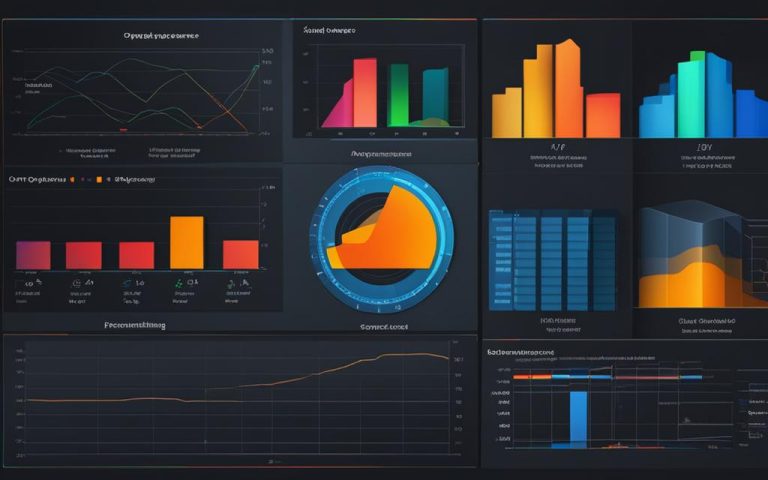Choosing the right operating system (OS) is crucial for enhancing efficiency and performance at the edge in edge computing applications. The OS plays a central role in the software infrastructure, impacting overall system performance and integration. To ensure the best fit for the network’s needs, key factors such as footprint, security, and maintainability should be considered when selecting an OS for edge computing.
An OS with a small footprint is advantageous for edge devices with limited storage space, allowing for better resource allocation. Robust security features are essential to protect edge applications from unauthorized access and potential threats. Additionally, maintainability is crucial for efficient management of updates and bug fixes, reducing downtime and optimizing the overall performance of the edge computing environment.
In this article, we will explore the considerations for choosing an OS for edge computing, highlighting some of the top solutions available. We will delve into the features and benefits of Windows IoT, Linux distributions, and Welotec egOS, providing insights into their capabilities and advantages. Furthermore, we will discuss different operating system designs, including minimalist, container-based, distributed, hybrid, and customizable options, to help you make an informed decision that aligns with your specific edge computing requirements.
Stay tuned for the next section where we dive deeper into the considerations for choosing an OS for edge computing.
Considerations for Choosing an OS for Edge Computing
When it comes to edge computing, selecting the right operating system (OS) is crucial for optimal performance and integration. Various considerations must be taken into account to ensure a seamless experience for edge applications. Let’s explore some of the key factors to consider when choosing an OS for edge computing:
Footprint
Edge devices often have limited storage space, making it essential to choose an OS with a small footprint. By opting for an OS that requires minimal storage, you can maximize the available resources on edge devices and ensure smooth operation of edge computing applications.
Security
Security is a top priority when it comes to edge computing applications. Edge devices are often deployed in remote or uncontrolled environments, making them susceptible to unauthorized access and potential security breaches. Therefore, it is crucial to select an OS that offers robust security features, such as an integrated firewall, to protect edge applications and data.
Maintainability
The ability to efficiently manage updates, patches, and bug fixes is another important consideration when choosing an OS for edge computing. An OS with user-friendly maintenance features allows for streamlined management processes, reducing downtime and the total cost of ownership associated with maintaining edge devices.
“Choosing an OS with a small footprint, robust security features, and efficient maintenance capabilities is crucial for successful edge computing applications.”
By carefully considering the footprint, security, and maintainability of an operating system, you can ensure the smooth operation and longevity of your edge computing applications. This will enable you to fully leverage the potential of edge computing and unlock its benefits for your organization.
Windows IoT for Edge Computing
Windows IoT, a member of the Windows family specifically designed for the Internet of Things (IoT), offers a range of powerful features tailored to edge computing environments. This operating system provides enterprises with robust security, efficient manageability, and extensive maintenance capabilities to ensure optimal performance and protection of edge devices.
One of the key highlights of Windows IoT is its emphasis on security. Regular updates and security patches are implemented to address vulnerabilities and safeguard edge applications and data. This proactive approach to security enables organizations to mitigate risks and maintain a secure edge computing ecosystem.
Furthermore, Windows IoT offers comprehensive maintenance and management capabilities, enabling organizations to effectively oversee their edge devices. Remote management features allow for centralized control and monitoring, facilitating efficient device administration and troubleshooting. Centralized update management simplifies the deployment of updates, patches, and bug fixes, ensuring that edge devices remain up-to-date and operating smoothly.
Windows IoT offers different editions to cater to a range of edge device requirements. For devices with limited memory, Windows 10 IoT Core provides a lightweight and optimized edition. It is specifically designed to efficiently run on resource-constrained devices. On the other hand, Windows IoT Enterprise caters to dedicated edge devices with specific applications, allowing for greater customization and flexibility.
| Features | Windows IoT Editions |
|---|---|
| Powerful enterprise-level features | Windows IoT Enterprise |
| Robust security | All Windows IoT Editions |
| Efficient manageability | All Windows IoT Editions |
| Extensive maintenance capabilities | All Windows IoT Editions |
Windows IoT provides organizations with a reliable and feature-rich operating system for their edge computing needs. With its enterprise-level capabilities, strong security measures, efficient manageability, and versatile editions, Windows IoT offers a solid foundation for building and managing edge computing infrastructures.
Linux Distribution for Edge Computing
When it comes to edge computing, selecting the right operating system is crucial for ensuring security, ease of maintenance, and optimal resource utilization. Linux distributions are renowned for their robust security features, efficient package management systems, and low memory requirements, making them an excellent choice for edge computing.
The architecture of the Linux kernel provides a strong foundation for enhanced security, reducing the susceptibility of edge devices to viruses and malware. This increased security is essential for protecting sensitive data and ensuring the integrity of edge applications.
Moreover, Linux distributions offer efficient package management systems, enabling seamless updates and bug fixes. This ease of maintenance ensures uninterrupted performance and allows for the timely implementation of security patches and new features.
One of the key advantages of Linux distributions for edge computing is their low memory requirements. This enables efficient resource utilization on edge devices with limited storage capacity, optimizing their performance and responsiveness.
Popular Linux distributions for edge computing include Ubuntu, which benefits from extensive community support and a wide range of available applications. Additionally, lightweight variants like Lubuntu provide a minimalistic and resource-efficient solution for edge devices with low memory requirements.
With their strong security features, ease of maintenance, and low memory requirements, Linux distributions are an excellent choice for edge computing environments.

| Advantages of Linux Distribution for Edge Computing | Examples |
|---|---|
| Strong security features | Ubuntu, Fedora, CentOS, Debian |
| Efficient package management systems | Arch Linux, openSUSE, Red Hat Enterprise Linux |
| Low memory requirements | Lubuntu, Xubuntu, Bodhi Linux, Puppy Linux |
Welotec egOS for Edge Computing
Welotec egOS is a powerful platform designed specifically for edge computing applications. With a strong emphasis on security, regular updates, security patches, and integrated firewall features are prioritized to ensure the protection of edge devices and applications. The egOS offers seamless integration with Azure IoT Edge, enabling easy provisioning and management of devices within the Azure ecosystem.
One of the notable advantages of Welotec egOS is its compatibility with a wide range of hardware platforms, providing flexibility and ensuring the right fit for each unique use case. This versatility allows organizations to leverage existing edge infrastructure while benefiting from the comprehensive features and functionality of the egOS.
Efficient device management is another key strength of Welotec egOS. The platform is equipped with Welotec Smart EMS software solution, enabling streamlined device management processes through centralized control and monitoring. This ensures optimal performance, timely updates, and efficient troubleshooting, ultimately reducing downtime and maximizing productivity.
Integration with Welotec VPN Security Suite
In addition to its core features, the egOS seamlessly integrates with the Welotec VPN Security Suite. This integration simplifies VPN configurations and provides secure remote access to connected devices, allowing organizations to securely manage and monitor their edge computing environment from anywhere.
Welotec egOS offers a comprehensive solution for edge computing, combining robust security measures, seamless integration with Azure IoT Edge, efficient device management capabilities, and secure remote access. This platform empowers organizations to unlock the full potential of edge computing and drive innovation in their respective industries.
Different Operating System Designs for Edge Computing
When it comes to operating system designs for edge computing, there are several approaches to consider. Each design offers unique features and advantages that cater to specific needs and preferences. Let’s explore some of these operating system designs:
Minimalist OS
A minimalist OS focuses on providing essential services and functions, stripping away unnecessary features to reduce complexity and maintenance cost. By prioritizing efficiency and performance, a minimalist OS optimizes resource usage and enhances the overall edge computing experience.
Container-based OS
A container-based OS leverages lightweight virtualization technology to isolate applications and their dependencies from the underlying infrastructure. This design allows for efficient management and scalability, enabling seamless deployment and updates of applications at the edge. Containerization also enhances security by isolating each application within its own environment.
Distributed OS
In a distributed OS, edge devices are treated as a single logical system, enabling resource sharing and coordination among multiple nodes. This design optimizes computing power and provides fault tolerance, as tasks can be distributed and executed across the network of edge devices. A distributed OS ensures efficient utilization of resources and enables seamless scalability.
Hybrid OS
A hybrid OS combines features from different operating system designs to provide flexibility and adaptability. By incorporating elements of minimalist, container-based, and distributed OS designs, a hybrid OS can meet diverse requirements and cater to various edge computing scenarios. This design allows for the best of multiple worlds, enabling customization while maintaining efficiency.
Customizable OS
A customizable OS empowers users and developers to configure and modify the operating system according to their specific needs and preferences. This design provides flexibility and enables tailoring the OS to suit unique edge computing requirements. With a customizable OS, organizations can leverage their expertise and adapt the system to maximize efficiency and performance.
Each operating system design has its own strengths and considerations, making it essential to carefully evaluate the requirements and goals of your edge computing environment. By selecting the right operating system design, you can optimize the performance, security, and scalability of your edge computing applications.
Conclusion
Selecting the right operating system (OS) is essential for optimizing edge computing. Considerations such as footprint, security, and maintainability play a crucial role in guiding the choice of OS. Windows IoT, Linux distributions, and Welotec egOS are popular options that offer diverse features and capabilities.
Windows IoT provides powerful enterprise-level features, robust security, and efficient manageability. It offers different editions tailored to meet the specific needs of edge devices. Linux distributions, on the other hand, are known for their strong security features, ease of maintenance, and low memory requirements. Ubuntu and Lubuntu are popular choices in this category.
Welotec egOS is a powerful platform designed specifically for edge computing applications. It prioritizes security with regular updates, security patches, and integrated firewall features. It also offers efficient device management and integration with the Azure IoT Edge ecosystem.
In addition to these specific OS options, there are different OS designs to consider. From minimalist and container-based OS to distributed, hybrid, and customizable OS, each design offers distinct advantages and trade-offs. Choosing the right OS ultimately depends on the specific requirements, security preferences, and available resources of the edge computing environment.
FAQ
What factors should I consider when choosing an operating system for edge computing?
When selecting an operating system for edge computing, it is important to consider factors such as the footprint, security, and maintainability of the OS.
What is Windows IoT and why is it suitable for edge computing?
Windows IoT is a member of the Windows family specifically designed for the Internet of Things (IoT). It offers powerful enterprise-level features, robust security, and efficient manageability, making it a suitable choice for edge computing applications.
What are the advantages of using Linux distributions for edge computing?
Linux distributions are known for their strong security features and ease of maintenance. They have low memory requirements and offer efficient package management systems for updates and bug fixes, making them a popular choice for edge computing.
What is Welotec egOS and why is it recommended for edge computing?
Welotec egOS is a powerful platform designed specifically for edge computing applications. It emphasizes security with regular updates, security patches, and integrated firewall features. It supports a wide range of hardware platforms and integrates seamlessly with Azure IoT Edge, making it a recommended choice for edge computing.
What are the different operating system designs available for edge computing?
There are several operating system designs for edge computing, including minimalist OS, container-based OS, distributed OS, hybrid OS, and customizable OS. Each design offers distinct advantages and trade-offs.
How important is the choice of operating system for optimizing edge computing?
Choosing the right operating system is crucial for optimizing edge computing. Factors such as footprint, security, and maintainability should guide the choice of OS to enhance efficiency and performance at the edge.
What are some top solutions for operating systems for edge computing?
Popular options for operating systems for edge computing include Windows IoT, Linux distributions, and Welotec egOS. Each solution offers its own unique features and benefits.



















